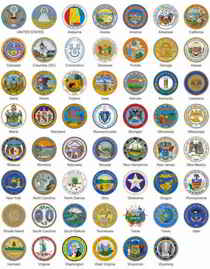

Florida Symbols
- » 50 States
- » Histories
- » State Symbols
- » Seals
Florida State Seal
Great Seal of the State of Florida

Adopted on May 25, 1861; Revised 1985.
The Great Seal of the State of Florida is used to represent the government of the state of Florida, and for various official purposes, such as to seal official documents and legislation. It is also commonly used on state government buildings, vehicles and other effects of the state government. It also appears on the state flag of Florida.
The seal features a shoreline on which a Seminole woman is spreading hibiscus flowers. Two of Florida's state tree, the Sabal palm, are growing. In the background a steamboat sails before a sun breaking the horizon, with rays of sunlight extending into the sky. The seal is encircled with the words "Great Seal of the State of Florida", and "In God we Trust".
Florida Great Seal
In 1985, Secretary of State George Firestone presented the revised Great Seal of the State of Florida to the Governor and the Cabinet. The previous State Seal had several errors which were corrected in in the 1985 Seal. This revised Seal has a Seminole Indian woman rather than a Western Plains Indian, the steamboat is more accurate, and the cocoa palm has been changed to a sabal palm as the Legislature prescribed in 1970.
The elements and basic design instructions for Florida's State Seal were established by the Legislature in 1868. Early that year, Florida's newly adopted State Constitution had directed that: "The Legislature shall, at the first session, adopt a seal for the state, and such seal shall be the size of an American silver dollar, but said seal shall not again be changed after its adoption by the Legislature."
So the Legislature, acting quickly upon the mandate, passed and sent to Governor Harrison Reed a Joint Resolution on August 6, 1868 specifying "That a Seal of the size of the American silver dollar, having in the center thereof a view of the sun's rays over a high land in the distance, a cocoa tree, a steamboat on water, and an Indian female scattering flowers in the foreground, encircled by the words, 'Great Seal of the State of Florida: In God We Trust', be and the same is hereby adopted as the Great Seal of the State of Florida." Some people also consider the "In God We Trust" phrase the State Motto, although there is no official designation of a State Motto in the Florida Statutes.
Florida's present Constitution, (Art. II, Sec. 4), continues to require the seal to be prescribed by law. In 1970, more than 100 years after the first specifications were drawn, the Florida Legislature made one change in the official description (CH. 15.03), changing "cocoa tree" in the former language to "Sabal palmetto palm." The sabal palmetto palm had been designated as State Tree in 1953.
Through the years, interpretations of the elements of the Great Seal have differed considerably. The steamboat, for instance, has been depicted in a variety of ways. The various images of the Indian female have drawn criticism from historians conscious of her clothing. The earliest official Great Seal pictured a mountainous background, something absent from the Florida terrain. Another effort showed a feather headdress on the Indian, a blunder insomuch as Indian males wore the headdresses.
Through it all, however, the elements in the Great Seal have remained consistent. Chapter 15.03 of the Florida Statutes in addition to specifying elements of the Great Seal, provides that the Department of State shall be the custodian of it, and that the Department of State alone has the authority to approve its use or display. A further provision prohibits any commercial use of the Great Seal.
Florida Law
Florida Statutes, Title 4, Chapter 15, Section 15.03.
15.03 State seal.--
(1) The great seal of the state shall be of the size of the American silver dollar, having in the center thereof a view of the sun's rays over a highland
in the distance, a sabal palmetto palm tree, a steamboat on water, and an Indian female scattering flowers in the foreground, encircled by the words "Great
Seal of the State of Florida: In God We Trust."
(2)(a) The Department of State shall be the custodian of the great seal of the state.
(b) The great seal of this state shall also be the seal of the Department of State, and the department may certify under said seal, copies of any statute,
law, resolution, record, paper, letter or document, by law placed in its custody, keeping and care, and such certified copy shall have the same force
and effect in evidence, as the original would have.
(3) Only the Department of State shall be authorized to affix the seal to any document for the purpose of attesting, certifying, or otherwise formalizing
such document. Any facsimile or reproduction of the great seal shall be manufactured, used, displayed, or otherwise employed by anyone only upon the
approval of the Department of State. The Department of State may grant a certificate of approval upon application to it by any person showing good
cause for the use of the seal for a proper purpose. The Department of State may adopt reasonable rules for the manufacture or use of the great seal
or any facsimile or reproduction thereof. Any person violating the provisions of this subsection is guilty of a misdemeanor of the second degree, punishable
as provided in s. 775.082 or s. 775.083.
History.--s. 4, ch. 1, 1845; RS 75; GS 76; RGS 90; CGL 112; s. 1, ch. 29841, 1955; s. 1, ch. 65-209; ss. 10, 35, ch. 69-106; (2)(a) formerly s. 21,
Art. IV of the Constitution of 1885, as amended; converted to statutory law by s. 10, Art. XII of the Constitution as revised in 1968; s. 1, ch. 70-300;
s. 11, ch. 71-136; s. 1, ch. 80-59.






